South Korean Art: A Guide to 12 Key Artists
Korean art has captivated global audiences with its unique blend of traditional techniques and innovative, contemporary expressions. Its popularity stems from the way it harmonizes elements of Korea's rich cultural heritage, such as calligraphy and ceramics, with modern themes and technologies, creating a distinctive style that speaks both to its historical roots and to contemporary experiences. Korean artists often explore themes of identity, technology, and nature, employing a diverse range of mediums to express complex emotional and societal narratives. This ability to merge the past with the present, along with a commitment to craftsmanship and conceptual depth, makes Korean art both distinctive and universally appealing. Korean artists are renowned for their dynamic fusion of traditional and contemporary practices, creating a compelling visual language that spans genres and generations. Their work, often characterized by innovative uses of material and exploration of cultural identity, continues to make a significant impact on the global art scene.
In this article, we will look at 12 notable Korean artists, providing insight into the lively and diversified art landscape that defines contemporary Korea.
1. Seo-Bo Park (1931-2023)
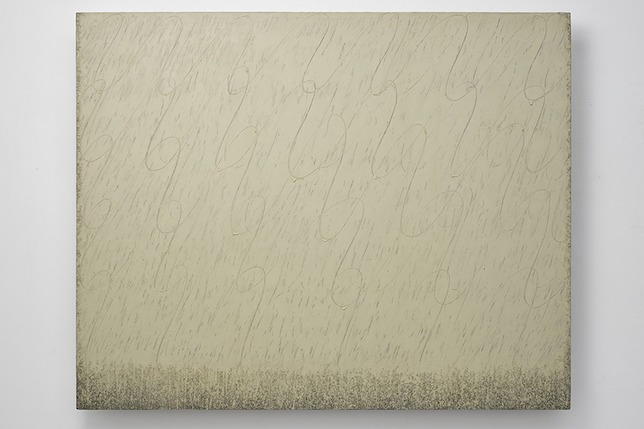
Park Seo-bo, Writing No. 26-75attacking, 1975
Seo-Bo Park is a distinguished artist famous for his contributions to abstract art and his role in the Dansaekhwa movement, which emphasizes monochrome painting and explores the materiality of the medium. His work is characterized by minimalist aesthetics, focusing on texture, repetitive gestures, and the interplay between form and space. One notable example of his work is the "Ecriture" series, where Park employs pencil lines on canvas to create intricate, grid-like patterns that suggest a form of script or writing, blending visual rhythm with the tactile quality of the materials. Another notable piece, "White Wrinkle," is from his later work and demonstrates his skill at using paint to create textured surfaces that exemplify Dansaekhwa, which emphasizes painting technique and materiality over representation.
2. Nam June Paik (1932-2006)

Nam June Paik "Tv Buddha" (1974)
Nam June Paik, a pioneer of video art, is celebrated for his groundbreaking contributions that fused technology with art, reshaping the landscape of contemporary media practices. Born in South Korea and having worked across Japan, Germany, and the United States, Paik's innovative approach to art anticipated the digital age, exploring the relationship between humans and technology. One of his most iconic works, "TV Buddha" (1974), features a closed-circuit television system displaying a live feed of a Buddha statue facing the screen, creating a loop that comments on the nature of viewing and the passage of time. Another significant piece, "Global Groove" (1973), is a dynamic video collage that combines diverse cultural imagery, music, and performances, broadcasted through a multilayered montage. This work not only highlights Paik's visionary use of video as an artistic medium but also anticipates the future of global communication and the interconnectedness of media cultures.
3. Lee Ufan (1936)

Lee Ufan "From Line" 1974
Lee Ufan is a seminal figure in contemporary art, known for his minimalist paintings and sculptures that embody the philosophical principles of the Mono-ha movement, which he helped pioneer in late 1960s Japan. Born in Korea in 1936, Lee's work is characterized by its focus on the relationships between materials, perception, and space, emphasizing the dialogue between the natural world and human intervention. One of his renowned series, "Relatum," features arrangements of stones and steel plates or other industrial materials, creating a stark yet harmonious dialogue between the organic and the man-made. These installations are based on Lee's belief in the 'art of encounter' where objects and space interact to produce new meanings. In his paintings, such as those from the "From Point" and "From Line" series, Lee applies paint in a methodical manner, with each brushstroke or point meticulously placed to invite contemplation on the act of creation and the passage of time. The restrained use of color and form in these works reflects his minimalist approach, focusing on the essence of expression and the materiality of the medium.
4. Wook-kyung Choi (1940-1985)

Wook-kyung Choi Lecommencement Est-le Conclusion 1965
Wook-kyung Choi was a pioneering South Korean artist known for her vibrant abstract expressionist paintings that bridged Eastern and Western art traditions. Her work, characterized by bold color palettes, dynamic compositions, and emotional intensity, reflects her exploration of personal identity and cultural displacement. Among her famous works, Choi's abstract compositions stand out for their innovative use of form and color, which were influenced by her studies in the United States and her exposure to American abstract expressionism. One of her notable series features collage techniques, incorporating traditional Korean paper (hanji) and calligraphy into her paintings, showcasing a unique blend of Korean heritage with Western modernist practices. Wook-kyung Choi's works can be seen in major art institutions in South Korea, including the National Museum of Modern and Contemporary Art, Korea, and the Seoul Museum of Art.
5. Bae Bien-U (1950)

Bae Bien-u "Sacred Wood" 2014
A distinguished South Korean photographer renowned for his ethereal and meditative landscapes that explore the profound connection between nature and spirituality. His photographs, often taken with a large format camera, are celebrated for their deep tonal range and the tranquil, almost mystical quality they evoke. One of his most famous series is "Sacred Wood," which captures the ancient pine forests of Gyeongju, a historical site in Korea. These black and white images, with their play of light and shadow, lead viewers into a serene, timeless realm where nature is both majestic and intimate. The composition and perspective imbue these trees with a dignified, almost sacred presence, reflecting Bae's interest in the philosophical and spiritual dimensions of the natural world. Another significant work by Bae Bien-U is his "Seascapes" series, where he turns his lens to the interaction between water and air at the horizon line. These images, characterized by their minimalist aesthetic, capture the vastness and dynamism of the sea, inviting contemplation on the elemental forces of nature and the human experience of observing and being within it.
6. Song Hyun-Sook (1952)

Song Hyun-sook "9 Brushes"
South Korean painter Song Hyun-Sook is well-known for her abstract and minimalist style. Her work is characterized by its meditative simplicity and the exploration of repetition and variation within a highly restrained palette and form. A notable aspect of her art is the series titled "9 Brushes," where she methodically applies nine brushstrokes to create each composition. This deliberate limitation in the number of strokes is not just a formal exercise but a deeply philosophical inquiry into the essence of painting, the act of creation, and the passage of time.
Her unique blend of traditional Asian aesthetics and contemporary minimalism has garnered international attention, making her works part of significant public and private collections worldwide. Song Hyun-Sook's paintings stand as a testament to the power of simplicity and the profound impact of a singular gesture in art.
7. Lee Bae (1956)

Lee Bae "Brushstroke"
Lee Bae, known for his exploration of the material and symbolic properties of charcoal, is a prominent figure in contemporary Korean art. His work, deeply rooted in the minimalist tradition, delves into themes of nature, time, and existence, employing charcoal not only as a medium but as a subject in itself. One notable example of Lee Bae's work is his "Issu du feu" series, where he uses charcoal and acrylic on canvas to create compositions that oscillate between abstraction and landscape. Another significant work, "Brushstroke" series, features sculptures and installations composed of charcoal segments arranged in patterns or loose aggregations. Through his innovative use of charcoal, Lee Bae continues to push the boundaries of contemporary art, offering profound meditations on the natural world and the human condition.
8. Choi Jeong Hwa (1961)

Choi Jeong Hwa "Breathing Flower"
Choi Jeong Hwa stands at the forefront of contemporary Korean art, merging incisive critiques of consumerism with captivating visual experiences. By transforming ordinary objects using vibrant hues and materials, Choi creates large-scale installations that draw the public into a dialogue with the art, prompting reflection on the overlooked beauty in everyday items. Among his celebrated creations, "Breathing Flower" features a kinetic, luminous red lotus that subtly moves as if alive, symbolizing vitality and renewal against urban backdrops. This piece, made from artificial materials, challenges observers to consider the interplay between the natural world and man-made surroundings. Similarly, "A Piece of Everyone" exemplifies Choi's vision of art as a communal encounter. This installation, a kaleidoscope of commonplace objects, merges art with daily life, urging viewers to reassess their consumer behavior and the possibilities for unity within communal spaces.
9. Lee Bul (1964)
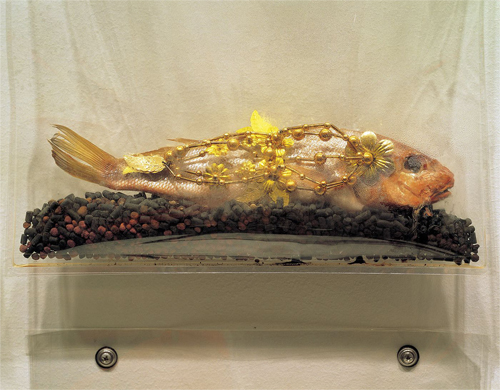
Lee Bul "Majestic Splendor"
Renowned for her avant-garde sculpture and installation work that explores utopian ideas, the politics of the body, and the intricate link between humans and technology, Lee Bul is an inspiring figure in Korean contemporary art. Her creations engage deeply with the historical and philosophical context of our times, upending conventional ideals of beauty and perfection. One of her notable installations, "Majestic Splendor," masterfully juxtaposes decaying fish with glittering sequins and beads, highlighting the transient allure of beauty and the degradation fueled by consumer culture. The "Cyborg" series presents an array of futuristic beings that merge the biological with the mechanical, challenging preconceived notions of body and identity in our digital era. Furthermore, "Via Negativa II" is an immersive mirror installation that prompts introspection among its viewers, exploring the intricacies of self-awareness and the subconscious. Lee Bul's artistry is not only visually striking but also intellectually stimulating, positioning her as a pivotal voice in the discourse on the human condition and societal dynamics today.
10. Haegue Yang (1971)
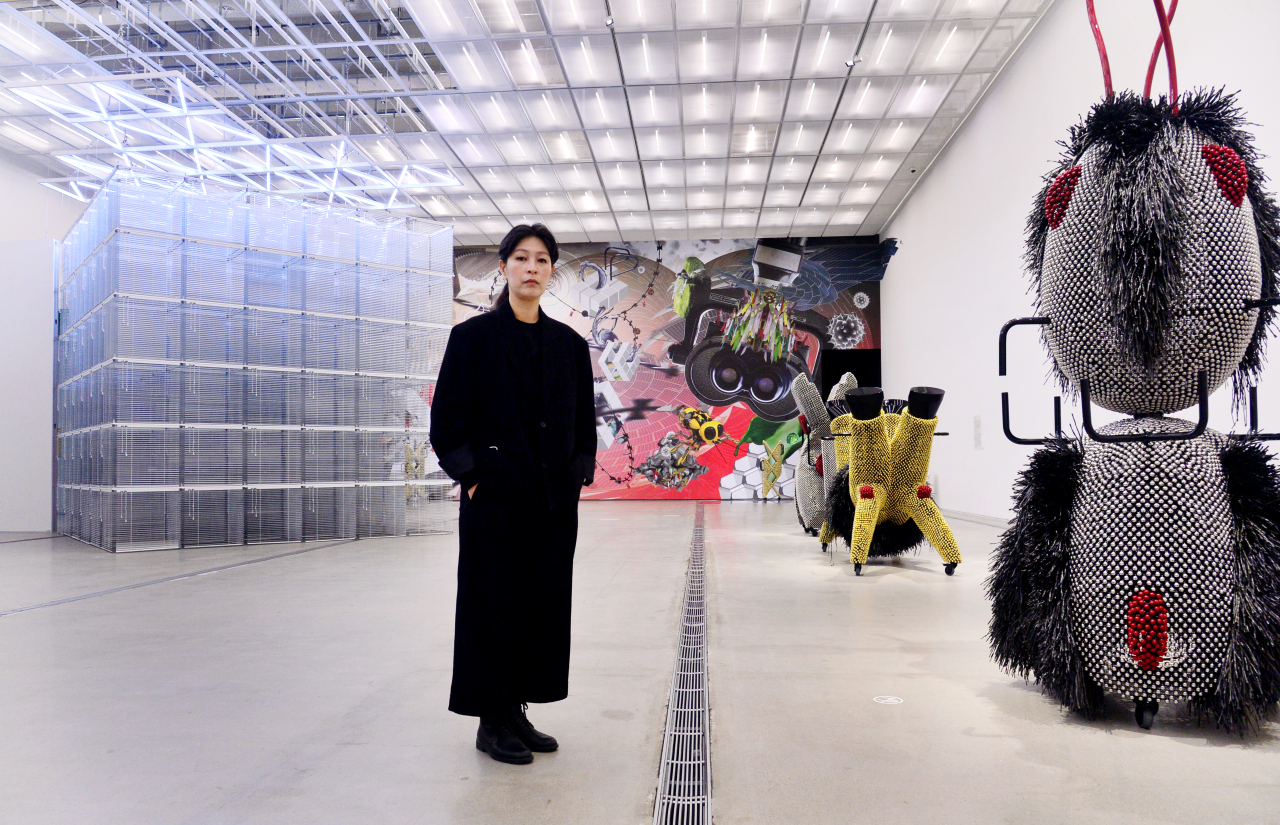
Haegue Yang "Sonic Sculptures"
Haegue Yang stands out on the international stage as a contemporary artist whose eclectic work spans collage, video, installation, and sculpture. Renowned for her innovative approach, Yang's creations draw upon a diverse array of materials from everyday objects and industrial components to elements that engage the senses, like light and fragrance. Through these means, she crafts captivating spaces that delve into themes of belonging, displacement, and cultural identity. Among her celebrated works, the "Sonic Sculptures" series merges visual and auditory stimuli, offering multi-sensory encounters that defy traditional notions of artistic space and structure. In her ongoing project "The VIP’s Union" since 2001, Yang orchestrates an assembly of furniture lent by a spectrum of contributors, from celebrities to ordinary individuals, challenging the distinctions between public and private domains, and the mundane versus the extraordinary.
11. Choi Xooang (1975)
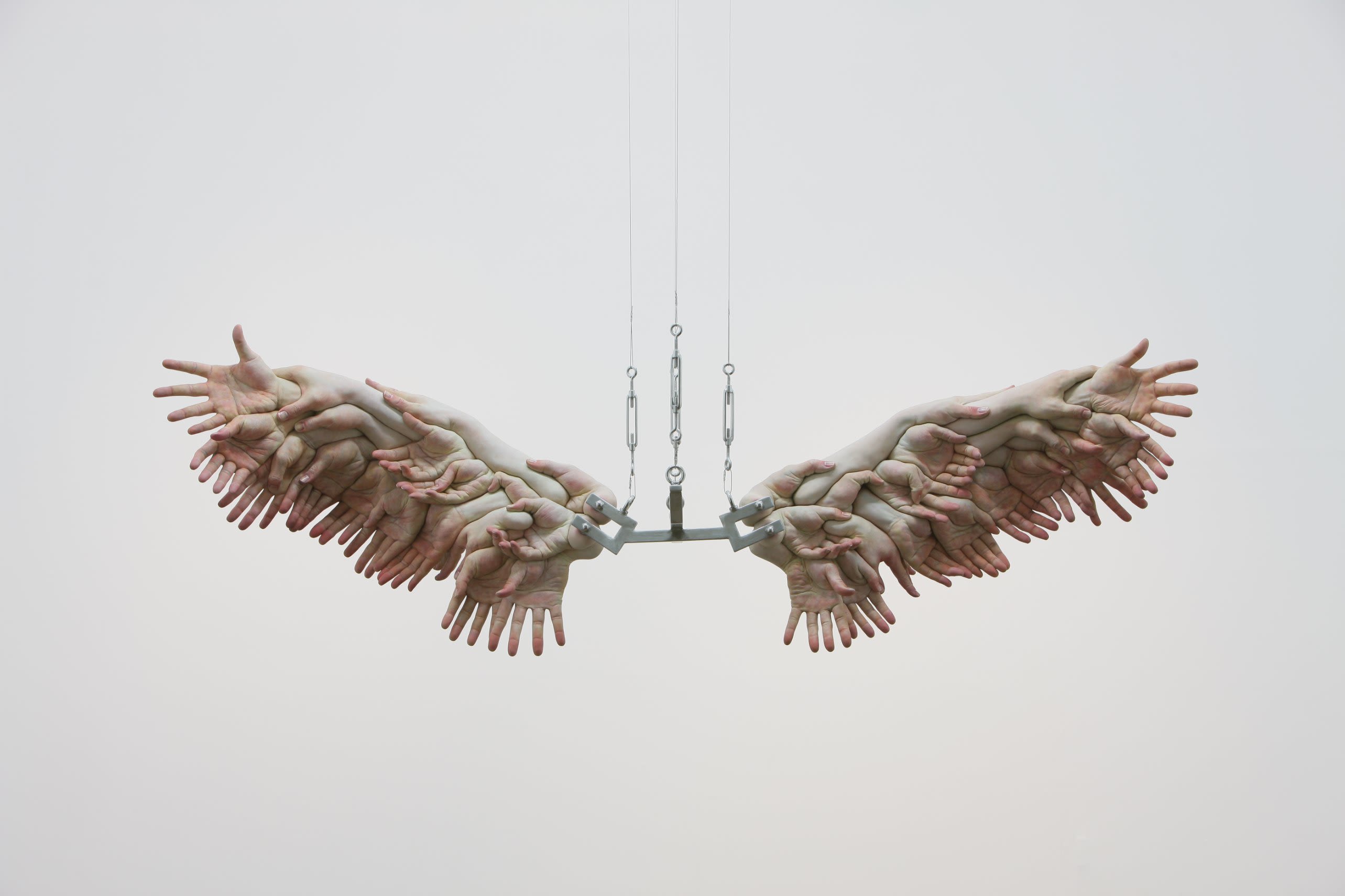
Choi Xooang "The Wing"
Choi Xooang is a South Korean artist renowned for his hyperrealistic sculptures that delve deep into the human psyche and the complexities of contemporary society. Working primarily with polymer clay and paint, Choi creates figures that are startlingly lifelike, often depicted in surreal or disturbing compositions that challenge viewers to confront uncomfortable truths about human existence and social issues. His works are characterized by an extraordinary level of detail, from the texture of skin to the expression of emotions, making each piece profoundly impactful. Notable works like "The Wing" and "Islet of Asperger" are poignant commentaries on the struggle for communication and understanding in an increasingly disconnected world. Through his art, Choi Xooang invites a dialogue on empathy, awareness, and the internal and external forces that shape our lives.
12. Soyoung Chung (1979)
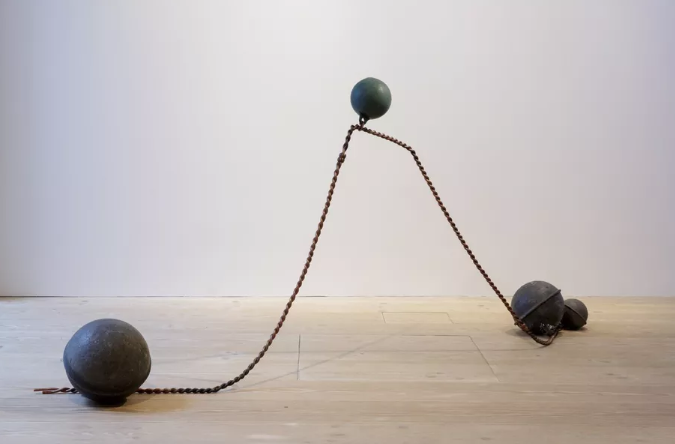
Soyoung Chung "Ori Mountain" (2016)
Soyoung Chung, an influential artist from South Korea, intricately navigates through the layers of memory, history, and the intricate dance between individual and shared identities through her diverse artistic expressions. Utilizing painting, installations, and video art, her creations offer a deep dive into the fleeting aspects of human existence, set against the ever-evolving landscapes of urban and natural Korea. Her works poignantly address how time affects our recollection and the act of forgetting, encapsulating those fleeting instants that define our sense of place and identity. Her piece "Ori Mountain" (2016) stands as a testament to Chung's exploration of memory, identity, and the environment, showcasing her ability to weave these themes seamlessly. Chung distinguishes herself with a meticulous choice of materials and a nuanced handling of visibility, blending the past with the present in her art. She challenges audiences to shift their perspectives on space and history, prompting a profound interaction with the narratives and significances embedded in our environments.
In the face of rapid changes, Korean artists are leading the way in breaking down barriers and creating art that explores both personal and collective experiences while critically analyzing and challenging identities!
No Comments Yet...